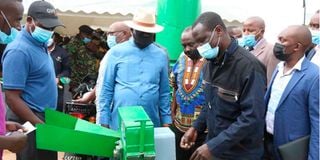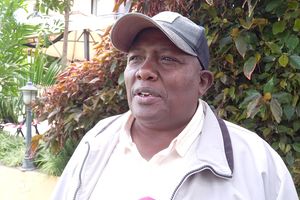Premium
Why we want to focus on making things in Mt Kenya

David Mathenge of Davina Engineering, right, explains to ODM leader Raila Odinga how a multipurpose silage chopper works during Laikipia SMEs Exhibition in Nanyuki town on September 26, 2021.
The ten Mt Kenya counties that comprise the central region economic block (CEREB) had an estimated 670,000 registered small businesses as of mid-last year.
This was a 31 per cent growth from 2016, when the number was 465,000.
Most micro businesses in the region as well as nationally are unlicensed. But more on this later. We are interested in licensed small business because the gross value added per worker is at least ten times higher among them as compared to the unlicensed micros. They therefore have the highest potential to increase both jobs and real wages.
Forty percent (265,000) of the licensed small businesses are small traders, shops or retail services, often with premises of 50 square feet or less.
But it is presence of significant number of manufacturing enterprises that is the cause of the greatest excitement. In this category we include those businesses that are categorized as small, medium and large size workshops; and small, medium and large industrial plants in the business licenses registers that are maintained by various counties.
The region has 27,200 manufacturing enterprises. And just as the size of the economies of respective counties vary from 100 to 650 billion, so too does the number of manufacturing enterprises in each county.
Meru has 5,700 manufacturing enterprises, while Muranga has 985. The respective figures are 8,100 in Nakuru, 589 in Laikipia, and 6,040 in Kiambu. If you were to include processors of agricultural produce the number would be higher still.
Why is this exciting news? Because the 27,000 manufacturers should be producing what the 265,000 retailers are selling. And with an economy bigger in size (US$27 billion) than Rwanda, Botswana or Mauritius, CEREB has critical mass to support rapid expansion of manufacturing. In fact, the gross county product of these ten counties is bigger than 34 different African countries.
And frankly it does not matter what your political inclinations are. The fact of the matter is that by supporting these manufacturers, we shall create hundreds of thousands of jobs.
That is why CEREB governors are working hard to improve market access for those manufacturing enterprises within the region. Discussions, currently at technical level, are exploring ways of eliminating double distribution costs.
Let me illustrate. Davina Engineering in Nanyuki is re-known for making high quality chaff-cutters. As a licensed business, Davina pays for an annual single business permit in Laikipia.
When Davina crosses over a few kilometres to Nyeri to sell their chaff-cutters to farmers in Kieni, they have to pay for another SBP, now in Nyeri, particularly if they are operating with a branded vehicle (which of course is better for brand recognition).
This is of course repeated in all other counties where Davina are selling chaff-cutters. We believe that by eliminating these multiple distribution costs, we shall make manufacturers like Davina more competitive, within the region and beyond.
In addition, individual counties are exploring other measures within their jurisdictions to promote domestic industry and create jobs. In Laikipia for example, we have focused on improving access to credit, reducing energy costs, and improving the physical operating environment.
We have done so by negotiating a Sh3.3 billion economic stimulus package that provides appropriately structured finance such as invoice discounting, LPO and asset finance, to our licensed small business at affordable rates.
In addition, we are providing qualifying manufacturing small business with energy rebates to enhance their competitiveness, particularly when pitted against producers from the far east.
In smart towns such as Oljabet, Rumuruti, Nyahururu and Nanyuki, we are expanding production spaces available for use by small business.
That is why for us in the mountain, it is all about the economy. Real, practical ways of creating jobs!
The writer is the independently elected Governor of Laikipia County.Twitter; @NdirituMuriithi





